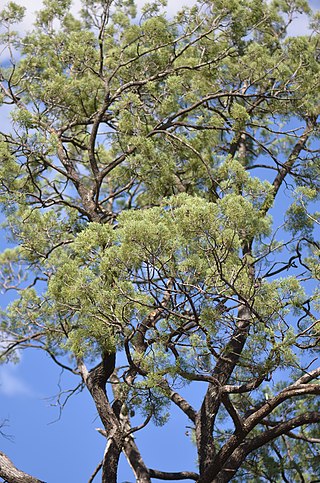
Dactylorhiza fuchsii, the common spotted orchid, is a species of flowering plant in the orchid family Orchidaceae.

Berthold Carl Seemann, was a German botanist. He travelled widely and collected and described plants from the Pacific and South America.

Acacia pulchella, commonly known as prickly moses or western prickly moses, is a shrub in the family Fabaceae. Endemic to Western Australia, it is one of the most common shrubs of the bushland around Perth and in the Darling Range.

The genus Tacca, which includes the batflowers and arrowroot, consists of flowering plants in the order Dioscoreales, native to tropical regions of South America, Africa, Australia, Southeast Asia, and various Oceanic islands. In older texts, the genus was treated in its own family Taccaceae, but the 2003 APG II system incorporates it into the family Dioscoreaceae. The APG III and APG IV systems continue to include Tacca in Dioscoreaceae.

Callitris columellaris is a species of coniferous tree in the family Cupressaceae, native to most of Australia. Common names include white cypress, white cypress-pine, Murray River cypress-pine, and northern cypress-pine. Callitris columellaris has become naturalised in Hawaii and in southern Florida.

Raukaua is a genus of flowering plants in the family Araliaceae. It has an austral distribution, being indigenous to southern Argentina and Chile, as well as New Zealand and the island of Tasmania.

Corymbia maculata, commonly known as spotted gum, is a species of medium-sized to tall tree that is endemic to eastern Australia. It has smooth, mottled bark, lance-shaped to curved adult leaves, flower buds usually in groups of three, white flowers and urn-shaped or barrel-shaped fruit.

Tacca leontopetaloides is a species of flowering plant in the yam family Dioscoreaceae. It is native to Island Southeast Asia but have been introduced as canoe plants throughout the Indo-Pacific tropics by Austronesian peoples during prehistoric times. They have become naturalized to tropical Africa, South Asia, northern Australia, and Oceania. Common names include Polynesian arrowroot, Fiji arrowroot, East Indies arrowroot, pia, and seashore bat lily.

Dactylorhiza maculata, known as the heath spotted-orchid or moorland spotted orchid, is an herbaceous perennial plant of the family Orchidaceae. It is widespread in mountainous regions across much of Europe from Portugal and Iceland east to Russia. It is also found in Algeria, Morocco, and western Siberia.

Ixia maculata is a species of flowering plant in the family Iridaceae known by the common name spotted African corn lily. It is native to the Cape Provinces of South Africa, but it is grown widely as an ornamental plant. It can also be found growing wild as an introduced species in several areas, including Western Australia. This perennial flower grows 20 to 70 centimeters tall with an erect, unbranched stem. There are a few twisting basal leaves up to 35 centimeters long. The inflorescence is a dense, showy spike of up to 12 flowers, usually orange to yellow in color, sometimes with areas of purple or red and often with spots; the coloration in garden plants varies due to breeding.

Tacca chantrieri is a species of flowering plant in the yam family Dioscoreaceae. It is commonly called the black bat flower.

Tacca integrifolia, the white batflower or black lily, is a species of flowering plant in the yam family of Dioscoreaceae. It is native to tropical and subtropical rainforests in hilly regions of South Asia from Pakistan to Bangladesh, Indochina, Malay Peninsular, Sumatra, Java and eastern China.

Mycena maculata, commonly known as the reddish-spotted Mycena, is a species of fungus in the family Mycenaceae. The fruit bodies, or mushrooms, have conic to bell-shaped to convex caps that are initially dark brown but fade to brownish-gray when young, reaching diameters of up to 4 cm. They are typically wrinkled or somewhat grooved, and have reddish-brown spots in age, or after being cut or bruised. The whitish to pale gray gills also become spotted reddish-brown as they mature. The stem, up to 8 cm (3 in) long and covered with whitish hairs at its base, can also develop reddish stains. The mycelium of M. maculata has bioluminescent properties. The saprobic fungus is found in Europe and North America, where it grows in groups or clusters on the rotting wood of both hardwoods and conifers. The edibility of the fungus is unknown. Although the species is known for, and named after its propensity to stain reddish, occasionally these stains do not appear, making it virtually indistinguishable from M. galericulata.

Dysoxylum arborescens, commonly known in Australia as Mossman mahogany, is a small tree in the mahogany family Meliaceae. It is native to rainforests of Malesia, Papuasia, Queensland and nearby islands.

Melaleuca incana, commonly known as grey honey-myrtle, is a plant in the myrtle family, Myrtaceae and is endemic to the south-west of Western Australia and is naturalised in the south of Victoria in Australia. It is commonly grown as a garden plant and produces large numbers of white or creamy yellow flowers, sometimes highly scented, in spring.

Melaleuca lateriflora, commonly known as gorada, is a plant in the myrtle family, Myrtaceae and is endemic to the south-west of Western Australia. It is usually an erect shrub with oval leaves and small clusters of white flowers mainly along the older branches.

Beyeria lechenaultii is a species of dioecious flowering plant in the spurge family, Euphorbiaceae, that is endemic to Australia.

Palaquium galactoxylum, commonly known as Cairns pencil cedar, Daintree maple or red silkwood, is a species of very large tree in the family Sapotaceae which is endemic to rainforests of New Guinea and northern Australia. It can produce spectacularly large buttress roots.

Bambusa textilis, also known as slender bamboo, clumping bamboo and weaver's bamboo, is a species of bamboo in the Poaceae (grasses) family that is native to China. The subspecies var. gracilis is heavily cultivated in Australia.

Heptapleurum ellipticum, commonly known in Australia as the climbing umbrella tree, is a plant in the family Araliaceae native to the Indian subcontinent, Indochina, Malesia, Papuasia and Australia.





















